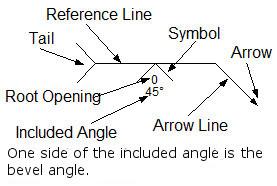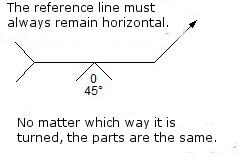AWS CWI, CWE, NDE Level III
- FMA
- The Fabricator
- FABTECH
- Canadian Metalworking
Categories
- Additive Manufacturing
- Aluminum Welding
- Arc Welding
- Assembly and Joining
- Automation and Robotics
- Bending and Forming
- Consumables
- Cutting and Weld Prep
- Electric Vehicles
- En Español
- Finishing
- Hydroforming
- Laser Cutting
- Laser Welding
- Machining
- Manufacturing Software
- Materials Handling
- Metals/Materials
- Oxyfuel Cutting
- Plasma Cutting
- Power Tools
- Punching and Other Holemaking
- Roll Forming
- Safety
- Sawing
- Shearing
- Shop Management
- Testing and Measuring
- Tube and Pipe Fabrication
- Tube and Pipe Production
- Waterjet Cutting
Industry Directory
Webcasts
Podcasts
FAB 40
Advertise
Subscribe
Account Login
Search
So, you want to be a CWI—Part IV
Joints and symbols
- By Professor R. Carlisle "Carl" Smith
- December 13, 2016
- Article
- Arc Welding
Editor’s note: This article is accompanied by many images of symbols, which can be viewed in the slideshow. A test also is included at the end of the article.
This part of the series is extremely important, because joints and symbols usually are found in more than one section of the certified welding inspector test. Anyone who is not familiar with weld symbols will be confused at first. This is an attempt to remove the confusion.
When the symbol is on both sides of the reference line (Figure 7), the weld is to be made on both sides of the joint.
One thing that you must remember is that there is no such thing as a butt weld. There are several butt joints, but no butt welds!
Square-groove welds, single-V-groove welds, double-V-groove welds, single-J-groove welds, double-J-groove welds, U-groove welds, double-U-groove welds, single-bevel-groove welds, and double-bevel-groove welds all are considered butt joints.
Figures 8-10 all are square-groove joints. The one in Figure 10 usually calls for a fillet weld, but as we will see next, there are many different T-joints.
Note that the straight line on the symbol always is shown to the left of the symbol.
If you take a look at some of the symbols, you can see where the test preparer is coming from. It is easy to see the pipe-to-plate weld area in Figure 16 (see slideshow). The semicircle refers to the pipe.
The symbol for a double-V-groove weld is shown in Figure 17 (see slideshow). The double-bevel groove has a K on the symbol and the plate (Figure 18).
Note that the weld size always goes to the left of the symbol no matter which side of the joint the symbol is displayed on. Again, the straight line always is shown on the left sideof the symbol, and the reference is always horizontal.Fillet Welds and Other Strange Ones
The symbols for fillet welds and others that are not as common are seen in Figures 20-26 in the slideshow. They define the proper weld for the joint.
The symbols in Figures 27-29 are incorrect, because one cannot see through the metal.
More Difficult Joints and Symbols for Fillet Welds
The symbols shown in Figures 30–32 in the slideshow show “weld distance” and “pitch distance.” The pitch distance indicates the center to center of the weld.
Figures 33–36 show additional symbols for difficult joints and fillet welds. The process for welding is shown in the tail for these welds.
The process should be shown in the tail for these welds.
Many other weld symbol configurations may accompany the design drawings or detail drawings. ISO symbols and nondestructive symbols are not included in this article. You should acquaint yourself with these variations.
The Big Test
- A butt weld is always made in the flat position?
- Yes
- No
- There’s no such thing as a butt weld
- Two pieces of plate butted together without a joint preparation is a?
- Single weld joint
- Nongrooved joint
- Square-groove joint
- When the symbol is shown on top of the reference line?
- The weld is to be made on the top of the material
- The weld is to be placed in the groove
- The weld is to be made on the other side
- The reference line may be pointed which way?
- Upward
- Downward
- Always horizontal
- The arrow line must always be pointed which way?
- Downward
- Upward
- Either way
- The pitch distance is?
- The length of the weld
- The center-to-center distance between welds
- The distance from the ends of the welds
- What is a pipe-to-plate weld symbol called?
- Flare-bevel groove
- Round-to-flat weld
- Spot weld
- What does a flag at the break in the reference line at the arrow line indicate?
- Weld must be made in the U.S.
- Weld must be made outside the shop
- Field welding crew must make the weld
- What does the circle at the break in the reference line at the arrow line indicate?
- The weld must be made of pipe or round bar
- Weld all around the part to be welded
- Weld up some misplaced holes
- What does the tail on a weld symbol indicate?
- Weld size
- Weld length
- Specific information such as process, gas, etc.
Answer key: 1) c; 2) c; 3) c; 4) c; 5) c; 6) b; 7) a; 8) c; 9) b; 10) c
About the Author

Professor R. Carlisle "Carl" Smith
Weld Inspection & Consulting
PO Box 841
St. Albans, WV 25177
304-549-5606
subscribe now

The Fabricator is North America's leading magazine for the metal forming and fabricating industry. The magazine delivers the news, technical articles, and case histories that enable fabricators to do their jobs more efficiently. The Fabricator has served the industry since 1970.
start your free subscription- Stay connected from anywhere

Easily access valuable industry resources now with full access to the digital edition of The Fabricator.

Easily access valuable industry resources now with full access to the digital edition of The Welder.

Easily access valuable industry resources now with full access to the digital edition of The Tube and Pipe Journal.
- Podcasting
- Podcast:
- The Fabricator Podcast
- Published:
- 04/16/2024
- Running Time:
- 63:29
In this episode of The Fabricator Podcast, Caleb Chamberlain, co-founder and CEO of OSH Cut, discusses his company’s...
- Industry Events
16th Annual Safety Conference
- April 30 - May 1, 2024
- Elgin,
Pipe and Tube Conference
- May 21 - 22, 2024
- Omaha, NE
World-Class Roll Forming Workshop
- June 5 - 6, 2024
- Louisville, KY
Advanced Laser Application Workshop
- June 25 - 27, 2024
- Novi, MI


































